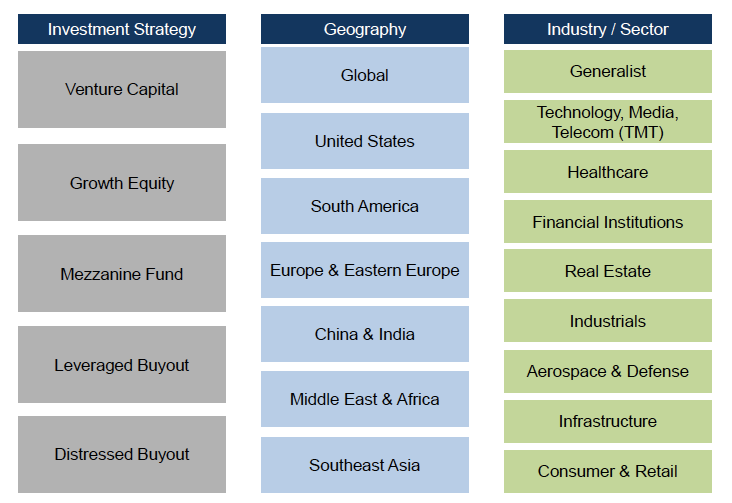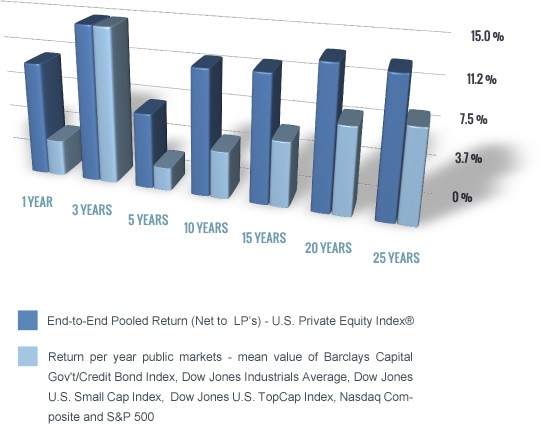How to Invest in Private Equity_1
Post on: 3 Июнь, 2015 No Comment

Time For Private Equity?
This is a good time to consider investing in private equity firms, a group that first came to most people’s attention last year when Mitt Romney was running for president. Romney, as you probably recall, made much of his fortune running one of the leading private equity firms, Bain Capital.
Although they may have a finger in a lot of different pies, private equity firms’ main business is taking controlling positions in major companies that have stumbled. They typically install new management with the goal of reinvigorating the company. When the business reaches their performance goals, which usually takes several years, they take the rehabilitated firm public again in an IPO, often realizing a big profit.
Why Now?
Private equity players were especially active in the 2004 – 2007 timeframe, gobbling up companies at a blistering pace.
Then the 2008/2009 economic downdraft cut the value of private equity holdings to the point where it didn’t make sense to sell them. Instead they held their holdings, waiting for the right time to sell. For most, that time arrived relatively recently.
Now, private equity players are bringing many investments they’ve held since the early 2000s to market, and realizing outsized profits along the way. Further, this trend is likely to continue for some time.
Three Publicly Traded MLPs
For the most part, only the wealthy can invest in private equity firms. However, a few are publicly traded. Of those, three are structured as limited partnerships, not corporations. Although they trade just like stocks, as partnerships, they do not pay corporate federal income taxes. As a result, partnerships generally pay significant dividends (called distributions). That is important now because those distributions are bound to increase as these firms convert more and more of their long-held investments to cash. On the downside, the tax returns for partnerships could be more complicated than for corporations.
Analyzing Candidates
Due to accounting quirks, reported earnings are not a reliable valuation gauge for private equity firms. It’s better to use book value, which measures assets minus liabilities, on a per-share basis. Thus, instead of using the price/earnings ratio to measure valuation, use the price/ book value ratio, which you can find on Yahoo’s (finance.yahoo.com ) Key Statistics report.
Analyzing private equity firm’s financial reports is a complicated task. Thus, it’s wise to let the stock analysts do the heavy lifting. After getting a price quote on Yahoo, click on Analyst Opinion. Yahoo organizes the ratings into consensus values ranging from 1 to 5 where 1 equates to “strong buy”, 3 is “hold,” and 5 means “strong sell.”
With that as background, here are the three private equity firms organized as limited partnerships.
Blackstone Group (BX)
With a market capitalization (value of shares outstanding) of $12.8 billion, Blackstone is the largest of the three. Besides for private equity investments, Blac kstone own commercial real estate, and offers financial advisory services to pension funds, financial institutions, and others. Formerly privately held, Blackstone went public in June 2007. Its price/book ratio is 2.3, and its consensus analyst rating (mean recommendations) is 1.9, which translates to a “moderate buy.”

Private equity firms typically pay distributions (dividends) that vary from quarter to quarter depending on each quarter’s earnings. Thus the yields displayed on most websites are not accurate because they assume that the last announced payout will continue unchanged for a year. Using analysts’ distribution forecasts for the next 12-months found on Thomson Reuters Knowledge, a pay site serving professional money managers, I estimated Blackstone’s distribution yield at 5.9%.
KKR & Co. (KKR)
Operating since the 1970s, KKR went public in July 2010. With a market-cap of $5.6 billion, KKR is about half the size of Blackstone. Not as diversified as Blackstone, KKR focuses mainly on private equity investments. The price/book ratio is 2.5 and its consensus analyst rating at 1.9, is the same as for Blackstone. Its estimated distribution yield is 7.4%.
Carlyle Group (CG)
Founded in 1987, Carlyle only went public in Mary 2012. With a market-cap of $1.3 billion, Carlyle is not only the newest but also the small of the three. Similar to Blackstone in diversity, Carlyle’s businesses include private equity, real estate, infrastructure and energy resources, distressed corporate opportunities and lending, and private equity funds of funds. The price/book ratio is lower than Blackstone and KKR at 1.5, but its analyst rating is 2.4, which is between “hold” and “moderate buy,” and its estimated distribution yield is 6.0%.
Thus, Blackstone and KKR are more in favor with analysts than Carlyle, but trading at higher valuations. Also, analysts expect KKR to pay a higher distribution yield than Blackstone or Carlyle.
I’ve described a “bare bones” analysis to get you started. If you’re interested, spend time doing your own research, starting with reading recent news stories about each candidate. The more you know about your stocks, the better your results.
published 8/11/13














